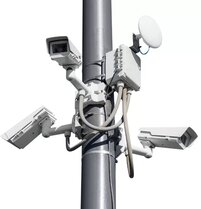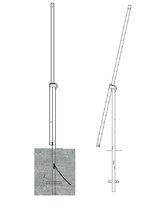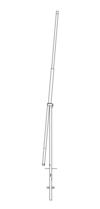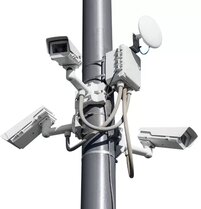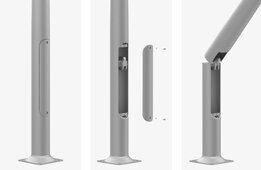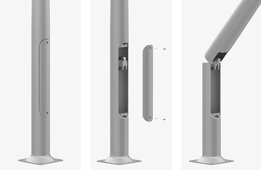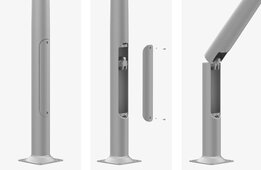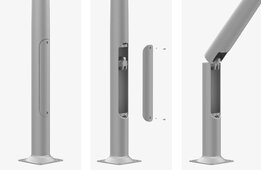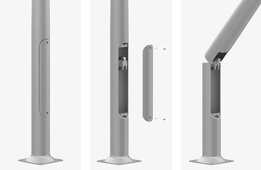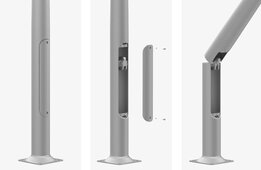
Vocare supplies camera masts and tilting masts for use by the government such as road authorities, companies and private individuals.
Below is an overview of tilting camera masts for camera security and tilting light masts.
Cameramast and Tiltingmast and hingemast from steel or aluminium is the choice when flexibility, safety and ease of maintenance are important.
Below is an overview of situations in which a tilting camera mast or light mast. is a good choice:
Ease of maintenance
Tilting masts make it possible to easily lower lamps, cameras or other equipment to the ground. This prevents the use of aerial work platforms or scaffolding and makes maintenance safer and more efficient.
Limited space or accessibility
In areas where there is little space for large maintenance vehicles, such as narrow roads, industrial estates or parks, a tilting mast offers a practical solution.
Safety
When working at height is risky, such as in environments with strong winds, a tilting mast is safer.
The tilting mechanism prevents the need to climb onto the mast.
Time saving
Because tilting can be carried out easily and quickly, the time required for maintenance is significantly reduced.
Use in remote or difficult to access areas
In locations where it is difficult to frequently use maintenance vehicles (for example along highways, dikes or in nature reserves), tilting masts are ideal.
Direct cost savings
Although tilting masts are more expensive to purchase, they can immediately save costs through easy accessibility of cameras, for example, and shorter maintenance times.
Special applications
Tiltingmasts and hingemasts are often used for street lighting, sports field lighting, camera masts, camera surveillance or on company premises where maintenance or adjustment is often required.
For camera surveillance and site lighting, a tilting mast is an excellent choice, especially in environments where regular maintenance is required or where safety is important. Here are the advantages specific to your situation:
Maintenance of cameras and lighting
The tilting mechanism makes it easy to bring cameras and LED lights to the ground, allowing maintenance or replacement to be carried out quickly and safely. You also do not need a lifting platform or additional personnel, which reduces costs and risks.
Safety
In a monitored area with cameras, it is important that maintenance does not cause unnecessary loss of time (for example due to prolonged downtime of a camera). With a tilting mast, the downtime is minimal.
- Working from the ground reduces the risk of accidents when working at height.
- Industrial area: Ideal due to the high intensity of lighting and the need for good visibility for camera surveillance.
- Construction site: Flexible for temporary setups and easy to move if necessary.
- Parking lot and storage areas: Easy to place and adjust cameras and lighting in strategic positions.
You can place the masts at different heights, depending on the field of view of the cameras and the coverage of the lighting.
The masts are also suitable for heavy equipment, such as PTZ cameras (Pan-Tilt-Zoom) and powerful LED spotlights.
Weather resistance and robustness
Tilting masts are often made of sturdy steel, which makes them suitable for outdoor use, even in severe weather conditions.
The tilt system remains functional, even in areas with strong winds or cold.
When choosing between steel and aluminum camera masts and steel camera masts, there are several factors to consider. Both materials have unique properties that may be more suitable, depending on your situation.
Here is an overview:
Steel tiltable camera masts
Strength and stability: Steel is very strong and offers excellent stability, even with heavy equipment such as PTZ cameras and large spotlights.
Weather resistance (galvanized steel with or without powder coating): Galvanized / zinc-plated steel or powder-coated steel offers good protection against rust and other weather influences.
Suitable for greater heights: For masts above 10 meters, steel is the best choice because of its strength.
Load capacity: Ideal for heavy accessories such as multiple cameras and lighting.
Aluminum tiltable cameramast and light masts
Lightweight: Aluminum is much lighter than steel, which makes it easier to transport and install.
Corrosion resistance: Aluminum does not rust, which makes it particularly suitable for use in coastal areas or humid environments.
If anodized aluminum, the lifespan is more than 50 years!
Maintenance-free
Aluminium does not require maintenance because it naturally forms an oxide layer that provides protection.
Aesthetic
Aluminum is strong, has a modern look and is available in various anodized or powder-coated finishes.
